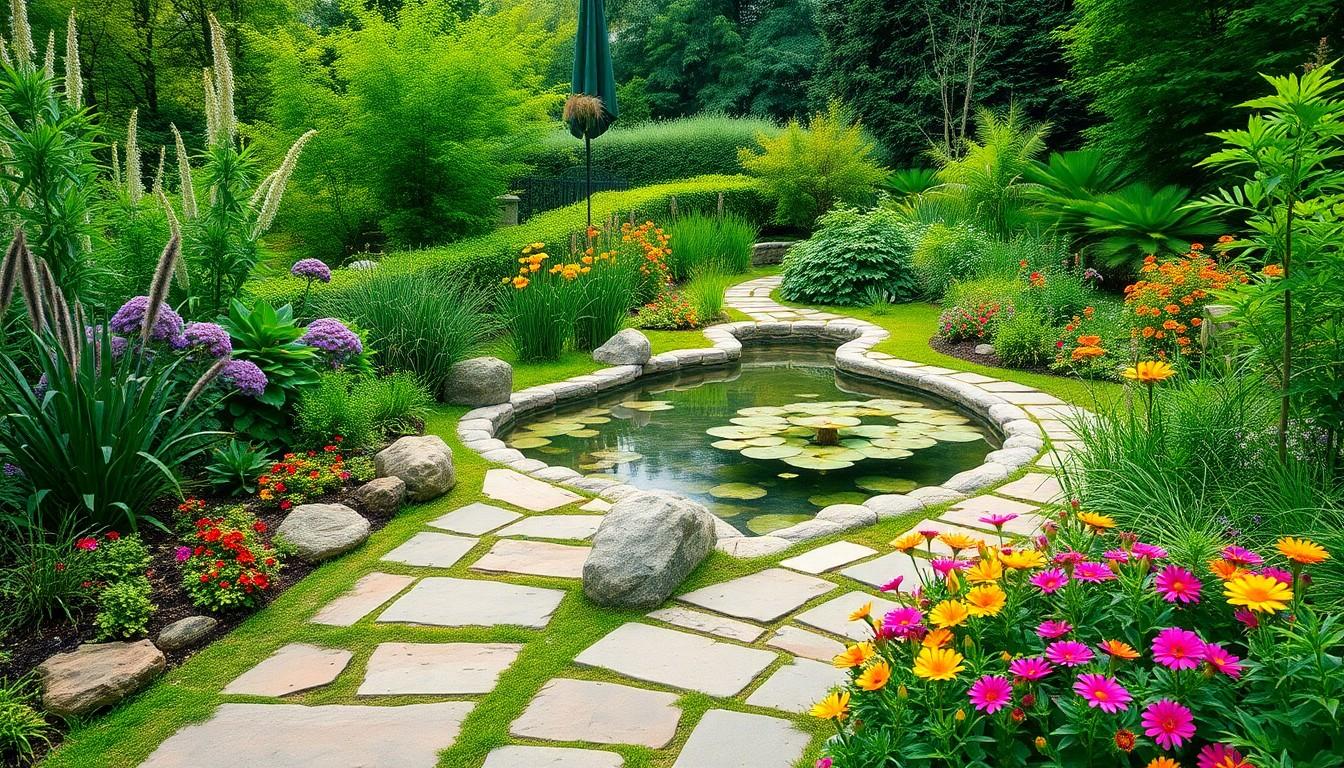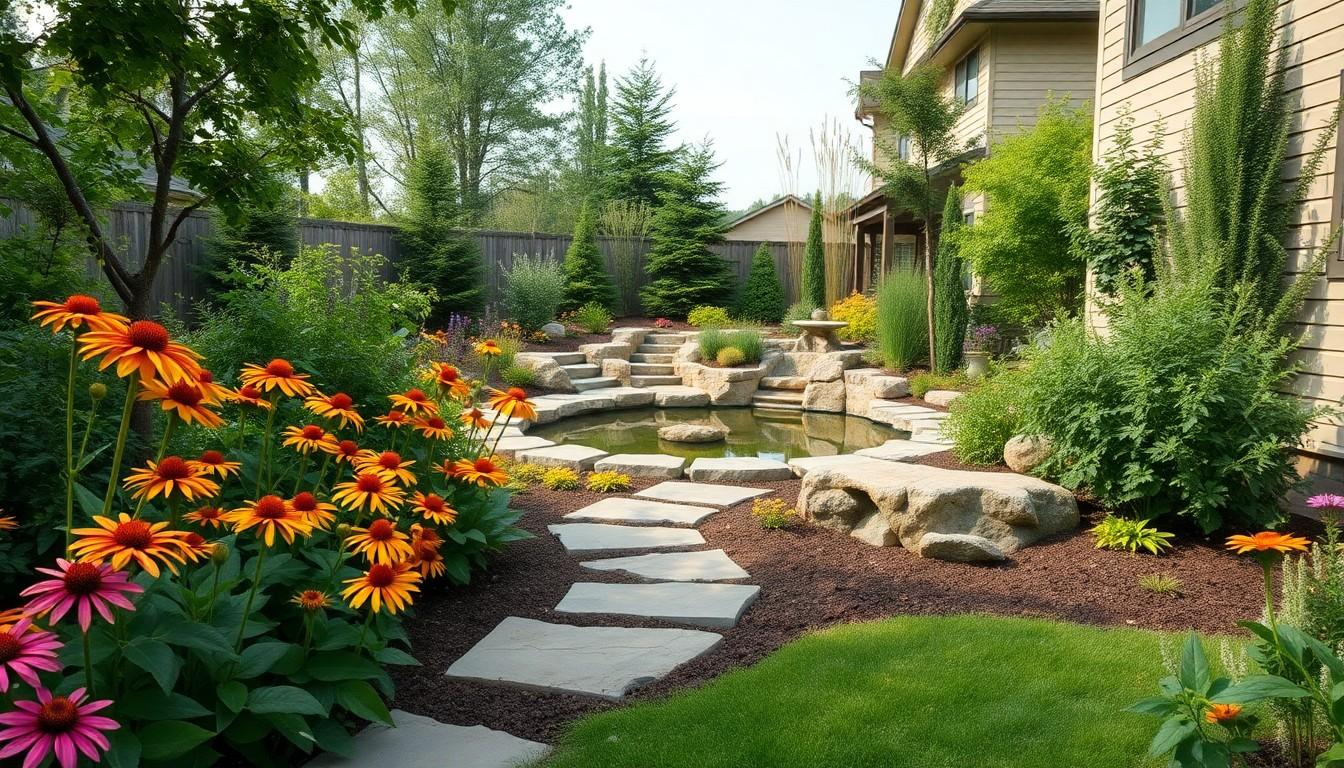Imagine stepping into your backyard and feeling like you’ve just entered a serene oasis instead of a patch of grass with a questionable garden gnome. Natural designs landscaping transforms ordinary spaces into breathtaking retreats, blending the beauty of nature with creative artistry. It’s like giving Mother Nature a makeover—one that’ll leave your neighbors green with envy.
natural designs landscaping
Natural designs landscaping emphasizes the integration of natural elements to create harmonious outdoor spaces. This approach prioritizes sustainability, promoting the use of native plants that require less maintenance and water. Creating diverse ecosystems, natural designs attract beneficial wildlife, enhancing the overall health of the landscape.
Incorporating features like stone pathways, water elements, and organic shapes enhances the aesthetic appeal. Such elements not only beautify spaces but also invite exploration and interaction. Designers often focus on layering textures and colors to mimic nature’s spontaneity, resulting in visually stunning landscapes.
When planning a natural landscape, considering environmental conditions is crucial. Soil type, sunlight, and climate influence plant selection, ensuring long-term viability and growth. Maintenance practices often involve minimal intervention, respecting the natural processes and allowing for a self-sustaining environment.
Natural designs landscaping offers numerous benefits beyond appearance. Studies show that green spaces improve mental health, boost creativity, and reduce stress. These positive effects contribute to the overall value of a property, making it more attractive to potential buyers.
Landscapers who specialize in this approach often work collaboratively with clients to ensure the spaces reflect personal styles while maintaining ecological integrity. This blend of artistry and practicality results in outdoor environments that invite relaxation and enjoyment while honoring nature.
Benefits of Natural Designs Landscaping

Natural designs landscaping provides several key advantages, including positive environmental effects and enhanced visual allure.
Environmental Impact
Natural designs landscaping promotes biodiversity. It supports local wildlife by incorporating native plants that require minimal water and maintenance. These plants adapt well to regional climates, reducing the need for chemical fertilizers and pesticides. Water features, such as ponds and rain gardens, help manage stormwater, improving drainage and promoting water conservation. Landscapes that mimic natural ecosystems foster healthier environments. They sequester carbon, improving air quality. In turn, this approach significantly diminishes the overall carbon footprint of outdoor spaces.
Aesthetic Appeal
Aesthetic appeal stands out in natural designs landscaping. Designers utilize a variety of textures and colors to create vibrant, dynamic environments. Stone pathways and organic shapes offer visual interest while inviting exploration. Focal points, like striking flowerbeds or tranquil water elements, enhance the overall beauty. These landscapes evoke a sense of serenity and harmony with nature. Each element’s placement reflects natural patterns, making outdoor spaces feel more inviting. Engaging with these visually stunning environments can elevate the mood and enhance the outdoor experience.
Design Elements of Natural Landscaping
Natural landscaping incorporates unique elements that emphasize harmony with the environment. Two key components essential to this design approach are native plants and water features.
Native Plants
Native plants play a pivotal role in natural landscaping. They thrive in local climates and soils, requiring less water and maintenance. These plants foster biodiversity, providing habitat for local wildlife such as birds and beneficial insects. Landscapers select species that complement the existing ecosystem, enhancing growth sustainability. Examples include coneflowers and black-eyed Susans, which attract pollinators and add vibrant colors. By minimizing the need for chemical fertilizers and pesticides, native plants promote healthier outdoor environments.
Water Features
Water features enrich natural landscapes by adding visual and auditory appeal. Ponds, streams, and rain gardens serve functional purposes while creating tranquil atmospheres. These elements facilitate stormwater management by allowing water to absorb into the ground, reducing runoff. They also support wildlife, drawing in frogs, birds, and beneficial insects. Incorporating water features introduces diverse ecosystems, which enhance aesthetic charm and encourage relaxation. Utilizing natural stone and organic shapes adds to the seamless blend with the surrounding landscape. Such features create inviting spaces that enhance the overall outdoor experience.
Implementing Natural Designs Landscaping
Natural designs landscaping focuses on creating inviting outdoor spaces that harmonize with nature. Key to success are effective planning and ongoing maintenance.
Planning and Design Process
Designers assess local environmental conditions, such as soil and sunlight. By selecting native plants, they enhance compatibility with the local ecosystem. Incorporating features like stone pathways and water elements encourages interaction. Visual elements, including varied textures and colors, create stunning landscapes and foster biodiversity. Collaboration with clients ensures that personal style aligns with ecological integrity, resulting in spaces that are both beautiful and functional.
Maintenance Tips
Minimal intervention is crucial for sustaining natural landscapes. Regular observation promotes health and prevents invasive species. Watering native plants less frequently conserves resources while allowing them to thrive. Mulching helps retain soil moisture and suppress weeds, reducing the need for chemicals. Periodic pruning supports growth and maintains appealing shapes in plants. Implementing these practices cultivates a vibrant environment that thrives organically.
Case Studies of Successful Natural Designs Landscaping
Numerous projects illustrate the effectiveness of natural designs landscaping. One notable example includes a residential backyard in Portland, Oregon. This transformation featured native plants, including coneflowers and black-eyed Susans, enhancing colorful displays while attracting local pollinators.
Another impressive case occurs in a community park in Seattle. Designers implemented a rain garden alongside stone pathways, which effectively managed stormwater. This feature not only reduced flooding but also created a serene environment that encourages community engagement.
In a suburban area of Austin, Texas, a family sought to convert their traditional lawn into a biodiversity haven. The designer replaced grass with a variety of native wildflowers and grasses, resulting in a minimal-maintenance landscape requiring little water. Visitors frequently enjoy its vibrant colors and diverse wildlife presence.
California also showcases a project focused on sustainability. An organic-shaped pond integrated into the landscape serves multiple functions. It supports local ecosystems while offering an attractive, interactive feature for families to enjoy.
Furthermore, an urban rooftop garden in New York City exemplifies how natural designs can thrive in limited spaces. Native plants were carefully selected to flourish in the rooftop environment while enhancing air quality. This project demonstrates that even urban settings can benefit from natural design principles.
Each case provides valuable insights into successful natural designs landscaping. They reveal how the combination of native plants, thoughtful planning, and interactive features results in sustainable, aesthetically pleasing environments. By observing these examples, individuals can glean inspiration for their own outdoor spaces.
Create A Space That Harmonize With Nature
Natural designs landscaping offers a unique approach to creating outdoor spaces that harmonize with nature. By prioritizing native plants and sustainable practices, it not only enhances beauty but also supports local ecosystems. This method invites exploration and interaction while fostering mental well-being.
As more people recognize the benefits of these landscapes, they’re transforming their backyards into serene retreats. With careful planning and collaboration, anyone can achieve a vibrant outdoor environment that reflects personal style and ecological integrity. Embracing natural designs landscaping is a step toward a healthier planet and a more enjoyable outdoor experience.

